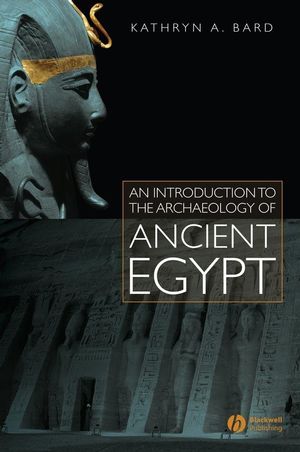|
Textbook
An Introduction to the Archaeology of Ancient EgyptISBN: 978-1-4051-1148-5
Paperback
420 pages
September 2007, ©2007, Wiley-Blackwell
 This title is out-of-print and not currently available for purchase from this site.
|
List of Figures.
List of Maps.
Abbreviations of References Listed in Suggested Readings.
Preface.
Acknowledgements.
1. Egyptian Archaeology: Definitions and History.
1.1: Introduction: ancient Egyptian civilization and its prehistoric predecessors.
1.2: Egyptian archaeology.
1.3: Egyptology.
1.4: History of Egyptology and Egyptian archaeology.
1.5: Archaeological methods.
1.6: Archaeological theory.
1.7: Ancient Egypt and Egyptian archaeologists in fiction and films.
2. Hieroglyphs, Language and Pharaonic Chronology:.
2.1: Language of the ancient Egyptians.
2.2: Origins and development of Egyptian writing.
2.3: Scripts and media of writing.
2.4: Signs, structure, and grammar.
2.5: Literacy in ancient Egypt.
2.6: Textual studies.
2.7: Use of texts in Egyptian archaeology.
2.8: Historical outline of pharaonic Egypt.
2.9: The Egyptian civil calendar, king lists, and calculation of pharaonic chronology.
3. The Environmental Background to Pharaonic Civilization: Geography, Environment, Agriculture, and Natural Resources:.
3.1: Geography: terms and place names.
3.2: Environmental setting.
3.3: Environmental and other problems for archaeology in Egypt.
3.4: The seasons and agricultural system.
3.5: The ancient Egyptian diet.
3.6: Other useful plants and animals.
3.7: Building materials.
3.8: Other resources: clays, stones, minerals.
3.9: Imported materials.
4. Egyptian Prehistory: Paleolithic and Neolithic:.
Paleolithic.
4.1: Paleolithic cultures in Egypt.
4.2: Lower Paleolithic.
4.3: Middle Paleolithic.
4.4: Upper Paleolithic.
4.5: Late Paleolithic.
4.6: Epipaleolithic.
Neolithic.
4.7: Saharan Neolithic.
4.8: Neolithic in the Nile Valley: Faiyum A and Lower Egypt.
4.9: Neolithic in the Nile Valley: Middle and Upper Egypt.
5. The Rise of Complex Society and Early Civilization:.
Predynastic Egypt.
5.1: The Predynastic Period: Egypt in the 4th millennium BC.
5.2: Lower Egypt: Buto-Ma’adi culture.
5.3: Upper Egypt: Naqada culture.
5.4: Lower Nubia: A-Group culture.
5.5: State formation and unification.
The Early Dynastic State.
5.6: Organization and institutions of the Early Dynastic state.
5.7: Early writing and formal art.
5.8: The expanding state.
5.9: Who were the ancient Egyptians?.
6. The Old Kingdom and First Intermediate Period:.
6.1: The Old Kingdom: overview.
The Early Old Kingdom.
6.2: The 3rd Dynasty: Djoser’s Step Pyramid at Saqqara.
6.3: The 4th Dynasty’s first king, Sneferu, and his three pyramids.
6.4: Khufu’s Great Pyramid at Giza.
6.5: The Great Sphinx and Khafra’s pyramid complex.
6.6: Menkaura’s Giza pyramid and its remarkable valley temple finds.
6.7: Giza pyramid towns.
6.8: Giza mastabas, Queen Hetepheres’s hidden tomb, and the workmen’s cemetery.
The Later Old Kingdom.
6.9: Sun temples of the 5th Dynasty.
6.10: Later Old Kingdom pyramids and the Pyramid Texts.
6.11: An expanding bureaucracy: private tombs in the 5th and 6th Dynasties.
6.12: Egypt abroad.
The First Intermediate Period.
6.13: The end of the Old Kingdom and the First Intermediate Period: causes of state collapse.
7. The Middle Kingdom and Second Intermediate Period:.
The Middle Kingdom.
7.1: The Middle Kingdom: overview.
7.2: Pre-unification 11th Dynasty: saff tombs at Thebes.
7.3: Mentuhotep II’s complex at Deir el-Bahri.
7.4: Model workers and the Deir el-Bahri tomb of Meketra.
7.5: 12th-Dynasty temples.
7.6: 12th- and 13th-Dynasty pyramids.
7.7: Towns and domestic architecture: Kahun and South Abydos.
7.8: Nomarchs in Middle Egypt: the Beni Hasan tombs.
7.9: Mining in the Sinai and a galena mine in the Eastern Desert.
7.10: Egyptian forts in Nubia and indigenous peoples there.
The Second Intermediate Period.
7.11: Second Intermediate Period: the Hyksos kingdom in the north.
7.12: The Kerma kingdom in Upper Nubia.
7.13: The Theban state during the Second Intermediate Period.
8. The New Kingdom:.
8.1: The New Kingdom: overview.
The Early New Kingdom.
8.2: Early New Kingdom architecture: Ahmose’s Abydos pyramid complex, and the Theban mortuary temples of Hatshepsut and Thutmose III.
8.3: Amenhotep III’s Malkata palace.
8.4: Tell el-Amarna and the Amarna Period.
8.5: The Amarna aftermath and Tutankhamen’s tomb.
New Kingdom Temples.
8.6: Restoration of the traditional gods: Sety I’s Abydos temple.
8.7: The temples of Karnak and Luxor in the New Kingdom.
8.8: Ramessid mortuary temples.
Royal and Elite Tombs.
8.9: Royal tombs in the Valley of the Kings and Valley of the Queens.
8.10: Elite tombs at Thebes and Saqqara.
State Towns and Settlements.
8.11: The workmen’s village and tombs at Deir el-Medina.
8.12: Nubian temple towns.
9. The Third Intermediate Period and Late Period:.
9.1: The Third Intermediate Period: overview.
9.2: The Late Period: overview.
9.3: Tanis: a new city with royal tombs.
9.4: Napata/Gebel Barkal and Sanam.
9.5: el-Kurru and Nuri: the Kushite royal tombs.
9.6: Saqqara: the Serapeum and animal cults.
9.7: Some high status tombs of the Third Intermediate Period and Late Period.
9.8: Tell el-Maskhuta and Tell el-Herr.
10. The Greco-Roman Period:.
Greco-Roman Egypt.
10.1: The Ptolemaic Period: overview.
10.2: The Roman Period: overview.
10.3: Alexandria.
10.4: Greco-Roman settlements in the Faiyum.
10.5: Two Greco-Roman temple complexes in Upper Egypt: Dendera and Philae.
Sites outside the Nile Valley.
10.6: The Western Desert: Bahariya and Dakhla Oases.
10.7: The Eastern Desert: Roman ports, forts, roads, and quarrying sites.
Nubia.
10.8: Qasr Ibrim.
10.9: Meroe: the Kushite capital and royal cemeteries.
11. The Study of Ancient Egypt.
Glossary of Terms.
Suggested Readings.
Appendix: Additional Readings in French, German, and Italian.
Chapter Summaries and Discussion Questions.
Index



